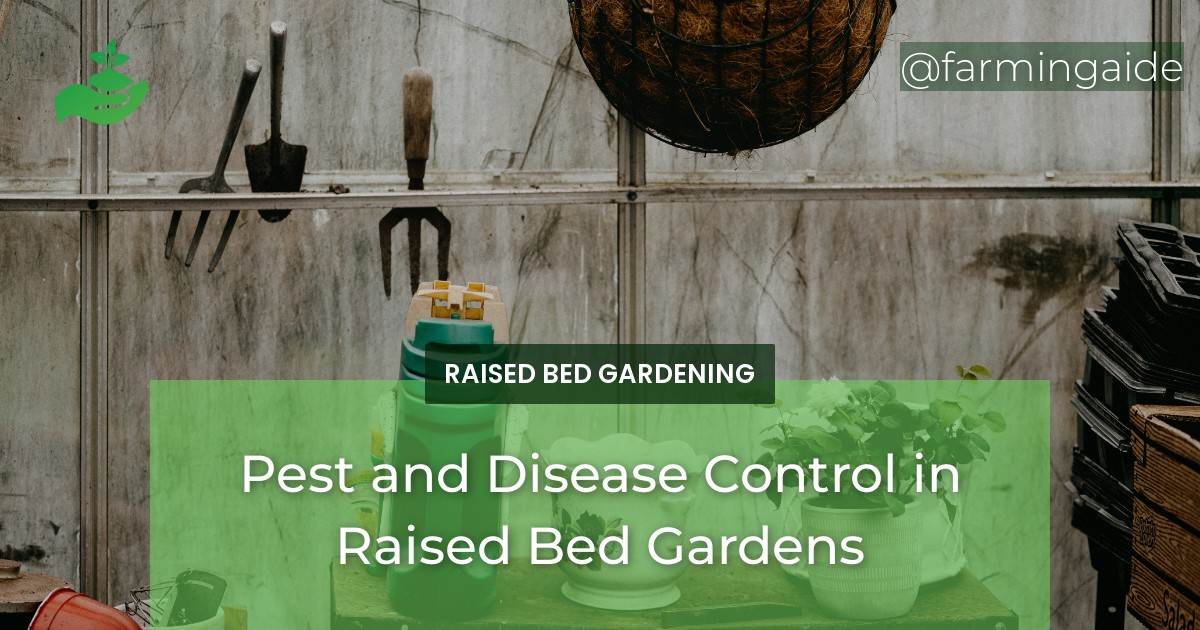Raised bed gardens are a great way to grow your own food, but they can also be susceptible to pests and diseases. This article will discuss pest and disease control by identifying some of the most common pests and diseases that can affect raised bed gardens, as well as some tips for controlling them.
Common Pests and Diseases in Raised Bed Gardens
Raised bed gardening is an efficient way of growing plants in a controlled environment. However, raised bed gardens are prone to pests and diseases that can destroy your plants if left unchecked. Here are some common pests and diseases in raised bed gardens:
Table of Contents
Identifying Common Garden Pests
It is vital to identify garden pests as early as possible to control and prevent infestations. The following are some common garden pests:
- Aphids – small insects that suck sap from plants
- Whiteflies – small, winged insects that feed on plant sap
- Slugs and snails – feed on leaves and stems of plants
- Caterpillars – larvae of moths and butterflies that feed on leaves and flowers of plants
- Spider mites – tiny arachnids that suck sap from plants
Identifying Common Garden Diseases
The following are common garden diseases that affect raised bed gardens:
- Blights – fungal diseases that cause leaves and stems to turn brown or black
- Mildews – fungal diseases that cause a white powdery coating on leaves and stems
- Rots – fungal diseases that cause plant tissues to decay and turn brown or black
- Viruses – diseases caused by viruses that affect plant growth and yield
ALSO READ
Symptoms of Pest and Disease Infestations
Here are some symptoms of pest and disease infestations:
- Yellowing or browning of leaves
- Wilting or drooping of leaves
- Discoloration or distortion of leaves and stems
- Stunted growth or lack of growth
- Presence of insects or pests on plants
- Presence of fungal growth on plants
Organic Pest Control Methods
Organic pest control methods are safer and healthier for your garden, environment, and food. Here are some organic methods of pest control:
Companion Planting
Companion planting is the practice of growing different plants together that complement or protect each other. For example, planting marigolds with tomatoes can repel nematodes and other pests that attack tomato plants.
Beneficial Insects
Beneficial insects are natural predators that prey on garden pests. For example, ladybugs feed on aphids and other soft-bodied insects. You can attract beneficial insects by planting flowers that provide nectar and pollen.
Natural Sprays and Solutions
Natural sprays and solutions are effective against garden pests without harming beneficial insects, birds, and animals. Here are some natural sprays and solutions:
- Neem oil – a natural pesticide that repels insects and prevents diseases
- Diatomaceous earth – a natural powder that kills insects with sharp edges
- Garlic spray – a natural repellent that repels insects and prevents diseases
- Soap spray – a natural solution that suffocates insects and prevents diseases
Disease Prevention Strategies
Prevention is better than cure when it comes to plant diseases. Here are some disease prevention strategies:
Proper Irrigation Techniques
Proper irrigation techniques can prevent waterborne diseases that affect plants. Here are some tips for proper irrigation:
- Avoid overwatering or underwatering plants
- Water plants at the base, not on the leaves
- Water plants in the morning or evening, not during the day
Soil Management and Fertilization
Healthy soil is essential for healthy plants that can resist diseases. Here are some tips for soil management and fertilization:
- Test your soil to determine its pH and nutrient levels
- Amend your soil with organic matter such as compost, manure, or mulch
- Rotate your crops to prevent soil-borne diseases and pests
Crop Rotation and Succession Planting
Crop rotation and succession planting can prevent soil depletion and disease buildup. Here are some tips for crop rotation and succession planting:
- Rotate your crops every season or year
- Plant crops with different nutrient needs and growth habits
- Plant cover crops to improve soil health and prevent erosion
Maintaining a Healthy Garden Ecosystem
A healthy garden ecosystem is vital for sustainable and productive gardening. Here are some tips for maintaining a healthy garden ecosystem:
Attracting Pollinators
Pollinators such as bees, butterflies, and hummingbirds are essential for plant reproduction and fruit production. Here are some tips for attracting pollinators:
- Plant flowers that provide nectar and pollen throughout the season
- Avoid using pesticides and herbicides that harm pollinators
- Provide nesting sites and shelter for pollinators
Mulching and Composting
Mulching and composting can improve soil health, prevent weeds, and conserve water. Here are some tips for mulching and composting:
- Mulch your garden with organic matter such as leaves, straw, or wood chips
- Compost your garden waste and kitchen scraps to create nutrient-rich compost
- Add compost to your soil to improve its structure, fertility, and water-holding capacity
Maintaining Garden Hygiene
Garden hygiene is essential for preventing the spread of pests and diseases. Here are some tips for maintaining garden hygiene:
- Clean your tools and equipment after each use
- Remove and dispose of diseased plants and plant debris
- Keep your garden weeds-free and well-maintained
Conclusion
Raised bed gardening can be a rewarding and productive way of growing plants. However, it requires proper pest and disease control, disease prevention, and garden ecosystem maintenance. By following the tips and methods outlined in this article, you can enjoy a healthy and thriving raised bed garden.
RELATED ARTICLES:


